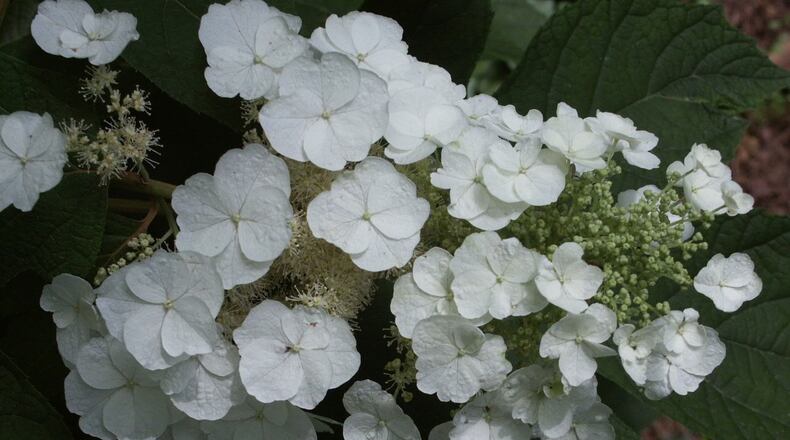Q: I have rooted several cuttings from an oak leaf hydrangea in a mixture of perlite and peat moss. I'm not sure what to do next. Jan Wright, Alpharetta
A: In a sheltered spot outdoors dig a trench 6 inches deep and a few feet long. Fill the bottom two inches of the trench with coarse gravel. When the leaves have fallen from your cuttings, re-pot them into individual gallon pots. Place the pots side-by-side in the trench, pack soil around them and place mulch over the soil. You should be able to see just the stems above the mulch. Unless we have a terribly cold winter, the cuttings will be happy in their pots and you can plant them wherever you like next spring.
Q: The county is going to repair the sewer line in my backyard soon. In the way are some 7-foot-tall azaleas. What's the best way to save them? Robert Leonard, DeKalb County
A: Grab some buddies or hire a small landscaping crew and put them on the calendar to come work for you. Thoroughly soak the soil under your azaleas at least twice before the workers come help you dig. If you plan to put the azaleas back in place after the sewer work is done, you can situate them side-by-side in a shady spot after being dug. Cover the roots with soil and keep it moist. Spray the foliage with water at least once per day. When the county work is done, re-install the azaleas and water regularly for the rest of this year and through next summer.
Q: I grew a row of peanuts for the first time this year but I don't know when to harvest them. Mike Childers, McDonough
A: You need to combine three observations to reach the conclusion that your peanuts are ready to harvest. The first observation is reading the seed label for your peanut variety. It will tell you approximately how many days it should take from planting to harvest. The second observation is the color of your plants. When harvest time approaches, the leaves will begin to transition from deep green to lighter green to slightly yellow to mostly yellow. The period between "slightly yellow" and "mostly yellow" is a good harvest time. The third observation comes from carefully excavating under the plant and pulling some of the underground peanuts. The seeds inside should be brown and mature-looking. Don't worry if you find a few immature peanuts that have just started to grow. There will always be a few of them under the plant at harvest time. It makes sense to dig up one plant to examine all of the nuts on it before you dig your entire crop. When plants have been unearthed, put them in a dry place for at least a week. It should be easy then to shake dry soil from the roots. Keep plants dry for another couple of weeks, until the leaves are dry and crumbly. At that point you can pull off all of the nuts and store for later enjoyment.
About the Author
The Latest
Featured

